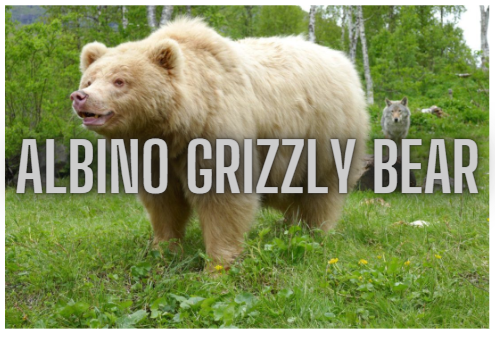Albino animals have captivated human fascination for centuries, and among these rarities is the albino grizzly bear. Grizzly bears (Ursus arctos horribilis) are already awe-inspiring creatures, but when an albino individual emerges from their ranks, it becomes an extraordinary occurrence. In this article, we will delve into the captivating world of albino grizzly bears, exploring their unique characteristics, challenges they face in the wild, and the implications of their presence on conservation efforts.
Understanding Albinoism
Albinism is a genetic condition characterized by the absence or reduction of melanin, the pigment responsible for the coloration of skin, hair, and eyes in animals. Albino animals exhibit a lack of pigmentation, resulting in pale or white fur, pink or light-colored eyes, and sometimes even a pinkish nose. Albinoism is a rare occurrence across all species, and albino grizzly bears are an exceptionally rare subset within this already uncommon phenomenon.
The Enigma of Albino Grizzly Bears
Albino grizzly bears are a subject of great intrigue and mystery. Their ghostly appearance sets them apart from their normally colored counterparts, making them easily recognizable in the wild. Their white or cream-colored fur can provide a stark contrast against the natural landscapes they inhabit. The pink or light-colored eyes of albino grizzly bears are also distinctive and lend an ethereal quality to their overall appearance.
Challenges Faced by Albino Grizzly Bears
The albino trait presents unique challenges for grizzly bears in the wild. The lack of pigmentation in their fur makes them more visible to predators, which can compromise their ability to blend into their surroundings and seek cover. Their light-colored eyes are more sensitive to sunlight, potentially affecting their vision and hunting capabilities. Additionally, their pinkish noses are more susceptible to sunburn and injury.
Survival and Adaptation
Albino grizzly bears face considerable challenges in survival due to their conspicuous appearance. Predation risk is heightened, as they are easily spotted by predators, such as wolves or other bears. Their reduced ability to camouflage may also affect their hunting success, as their prey can detect them more easily. However, albino grizzly bears have demonstrated resilience and adaptability. They may adopt different behavioral patterns, such as being more active during twilight hours or seeking shelter in dens or forested areas to mitigate their vulnerabilities.
Conservation and Management
The presence of albino grizzly bears raises important considerations for conservation efforts. These unique individuals occupy a special place in the natural world, and their protection is crucial to maintain biodiversity. Conservation organizations and wildlife management agencies work to ensure the long-term survival of these rare bears by implementing measures to safeguard their habitats, reduce human-wildlife conflicts, and raise awareness about their significance.
Educational Opportunities
Albino grizzly bears offer valuable educational opportunities for researchers, conservationists, and the general public. Studying these rare individuals provides insights into the genetic diversity and adaptability of grizzly bears. Their presence can also serve as a catalyst for broader discussions on conservation, the impacts of climate change, and the importance of preserving natural ecosystems.
Final Thoughts
Albino grizzly bears are a captivating and enigmatic phenomenon within the natural world. Their rarity and unique appearance make them a subject of intrigue and wonder. While albinoism presents challenges for their survival, these bears demonstrate resilience and adaptability. Protecting and conserving albino grizzly bears is essential for maintaining biodiversity and understanding the intricate dynamics of grizzly bear populations. By raising awareness and implementing conservation measures, we can ensure the continued existence of these remarkable creatures and appreciate the remarkable beauty they bring to our natural landscapes.ShareRetry

